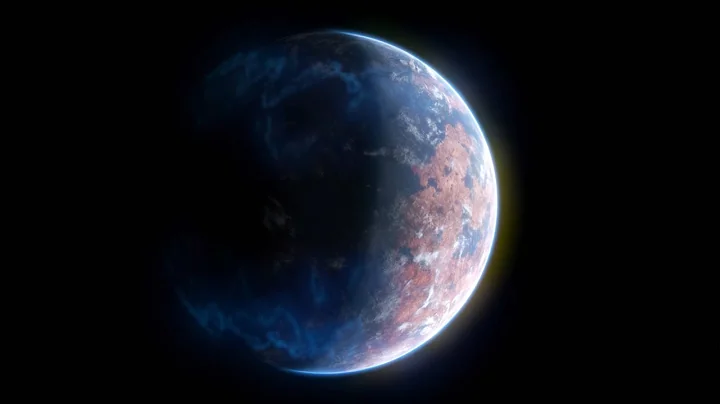In fact, Mars was not a cold, barren planet at the beginning, covered by violent dust and storms. Instead, it started out as a warm planet with liquid water, lakes, and probably was very habitable at some point in Mars' history.
Scientists generally believe that this climate change on the Red Planet is caused by the disappearance of its magnetic field. The planet's magnetic field is the fundamental factor that determines the fate of Mars. The magnetic field is a layer of invisible charged particles. The Earth's magnetic field wraps and protects the Earth like a blanket.
When a solar storm hits the Earth, the magnetic field forces it to flow around the Earth rather than reaching the atmosphere or surface. This prevents the flow of charged particles from transferring energy to gas molecules in the atmosphere, which would otherwise easily escape. Earth's gravitational pull. Without the magnetic field, the fate of the earth will be like Mars.

But if Mars once had a strong magnetic field, what went wrong with it? How did a once warm planet turn into a cold, dry and barren world? And most importantly, will this be the ultimate fate of the planet?
This is the Universe Science and Technology Club, I am Xiao Mo, welcome to follow this column.
Let us first look at our own planet. On the earth, the magnetic field is generated by the magnetohydrodynamic generator effect. We know that the outer core of the Earth is liquid and the inner core is solid. As it flows from the inner core to the outer core, it creates an induced current in the outer core liquid. These currents flow further, driven by the Earth's rotation, and eventually these currents create a magnetic field, forming the Earth's magnetosphere.
Scientists believe that similar magnetic fields were produced on Mars in the past. To confirm their hypothesis, scientists used data from NASA's InSight spacecraft launched to Mars. InSight is a robotic lander designed to study the Red Planet's deep interior.

It was launched on May 5, 2018, and is still actively studying the geological evolution of Mars. So far, InSight has collected some key data about the interior structure of Mars. These data indicate that the Martian core is larger and less dense than previously thought. Additionally, these data show that there are other, lighter elements in the Martian core, such as hydrogen in the core..
The study is a departure from previous models, which never included the possibility of hydrogen inside Mars' core. After obtaining key data from the InSight lander, researchers conducted an interesting experiment.
First, they prepared a sample that matched what they thought Mars was once composed of iron, sulfur and hydrogen. The sample is then placed in a diamond anvil cell, a device that compresses the sample between two small diamond plates. The device can withstand pressures of tens of billions of pascals.
Additionally, the researchers used lasers to heat the samples and simulate conditions inside the Martian core. Finally, when the team subjected the sample to higher temperatures and pressures, they used X-rays from an electron beam to track changes in the sample. To their surprise, not only did the sample melt, but the composition of the material also changed.

Iron, sulfur and hydrogen are normal at the beginning, but as the temperature and pressure conditions change, the originally uniform iron, sulfur and hydrogen separate into two different liquids, which is very complicated. One of the molten irons is rich in sulfur, while the other is rich in hydrogen.
Among these separated liquids, the denser ones remain in the deepest part, while the lighter ones flow upward and mix with the overall liquid core. The movement of these liquids creates convection currents, which create magnetic fields. Fortunately, these convection currents are still going on inside the earth.
This experiment proved that Mars may have had a magnetic field in the past, but these currents only lasted for a period of time, so the magnetic field of Mars also disappeared. Experiments show that when the two liquids separate, the current disappears, which explains the disappearance of Mars' magnetism.
In this way, because Mars lost its magnetic field, it also lost its atmosphere. This event is thought to have occurred 4 billion years ago.

The core of Mars is currently inactive, but another part of the data shows that there is still movement inside Mars. Time and time again, InSight has discovered new seismic events on Mars. However, since the earthquakes do not follow any specific pattern in the timing of their occurrence, it is clear that they are not the result of the planet's interaction with its satellites.
Additionally, earthquakes occurred repeatedly at all times of the Martian day, suggesting that the movement of molten lava in the Martian mantle triggered Martian earthquakes in the region. The study also found that the area has been highly volcanically active over the past 10 million years, an activity attributed to repeated movements of Martian magma, suggesting that Mars is more seismically and volcanically active than we thought.
Mars is an interesting world for us, and understanding its activity and evolution is crucial to the task of designing the future of human civilization. The temperature inside the Earth continues to drop, making it more practical to study the geological changes on Mars. Scientists believe that if the interior of the Earth is completely cooled and solidified, it will become the second Mars.
The questions are endless, and so are human explorations to find answers. Do you think Earth will become the second Mars? Please tell us your thoughts in the comments section. If you like this episode, please subscribe to our channel for more Discovery shows.





















